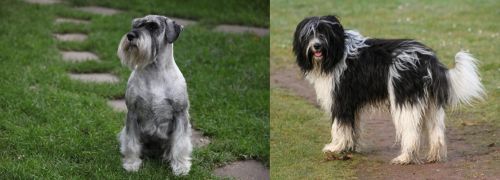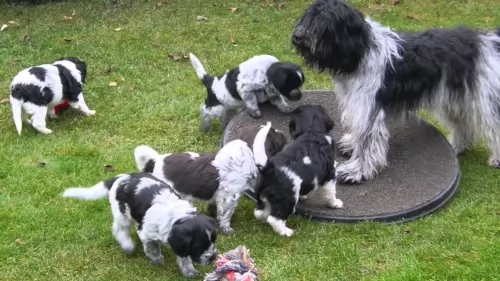 MyDogBreeds
MyDogBreeds Standard Schnauzer is originated from Germany but Schapendoes is originated from Netherlands. Both Standard Schnauzer and Schapendoes are having almost same height. Both Standard Schnauzer and Schapendoes are having almost same weight. Both Standard Schnauzer and Schapendoes has almost same life span. Standard Schnauzer may have more litter size than Schapendoes. Standard Schnauzer requires High maintenance. But Schapendoes requires Moderate maintenance
Standard Schnauzer is originated from Germany but Schapendoes is originated from Netherlands. Both Standard Schnauzer and Schapendoes are having almost same height. Both Standard Schnauzer and Schapendoes are having almost same weight. Both Standard Schnauzer and Schapendoes has almost same life span. Standard Schnauzer may have more litter size than Schapendoes. Standard Schnauzer requires High maintenance. But Schapendoes requires Moderate maintenance
 Coming out of Germany in the 14th and 15th century is the Standard Schnauzer or Mittelschnauzer. Both the Giant Schnauzer and Miniature Schnauzer are descendants of the Standard Schnauzer. The first name for this breed was the Wire-haired Pinscher until 1879. The breed is a working breed that is popular in Europe and was first in a dog show in 1879 in Hanover, Germany. In 1997 they won Best in Show at the Westminster Kennel Club in New York.
Coming out of Germany in the 14th and 15th century is the Standard Schnauzer or Mittelschnauzer. Both the Giant Schnauzer and Miniature Schnauzer are descendants of the Standard Schnauzer. The first name for this breed was the Wire-haired Pinscher until 1879. The breed is a working breed that is popular in Europe and was first in a dog show in 1879 in Hanover, Germany. In 1997 they won Best in Show at the Westminster Kennel Club in New York.
These medium size Schnauzers were bred in the Middle Ages to be versatile in working and herding in Germany. There seems to be artwork from the 14th through the 16th centuries featuring this breed of dog as a hunter. It is believed that the common ancestors of the Standard Schnauzer is the German Pinscher and the gray Wolf Spitz, along with the black German Poodle and the Bolognese.
It was 1850 when the breed gained recognition as a purebred with distinct and recognizable features. Those are not all the same features that the dogs of today show. These dogs had thick hair on their face, a double coat that is wiry, and their tails were cropped. These dogs were initially Wire-haired German Pinscher then in 1879, a dog named Schnauzer won Best in Show in Hanover. By 1900, the breed was being called Schnauzer everywhere.
The first breed standard was written under the Wire-haired German Pinscher name in the early 1880’s. This standard allowed for a lot of different colors, but the salt and pepper of today was not introduced until the late 1800’s. Then the standard was rewritten in 1907 for the Standard Schnauzer with this as the dominant color.
The first official Standard Schnauzer imported to the United States came in 1905 even though there is a claim that one competed in the 1899 Westminster Kennel Club in the Miscellaneous Class. Following the first World War, the breed became increasingly popular in the States. At that time the US club was called the Wire-haired Pinscher Club of America in 1925. Both standard and miniature sized schnauzer are included in this club.
The breeds were separated in 1933 and became the Standard Schnauzer Club of America and classified by the American Kennel Club as part of the Working Group. In 1926 they moved the Standard Schnauzer to the Terrier Group. By 1926 the Schnauzer Club of Great Britain was formed.
 Known also as the Dutch Sheepdog, the Schapendoes originates in the Netherlands.
Known also as the Dutch Sheepdog, the Schapendoes originates in the Netherlands.
It has always been known as a herding dog and farm dog. There were times during the 1940s when the dog’s numbers dropped considerably, but fortunately a breed club known as the Nederlandse Schapendoes was formed in 1947.
It wasn’t until 1971 that the dog earned recognition as a Dutch breed and the Federation Cynologique Internationale recognized this Dutch Sheepdog in 1989.
 Today’s Standard Schnauzer is a square, robust, medium sized dog. The breed boasts heavy eyebrows and thick beards. They are salt and pepper or black and their coat is wiry and stiff. The breed have excellent muscle tone and a body in proportion height to length. Their build is rugged, and coat is dense.
Today’s Standard Schnauzer is a square, robust, medium sized dog. The breed boasts heavy eyebrows and thick beards. They are salt and pepper or black and their coat is wiry and stiff. The breed have excellent muscle tone and a body in proportion height to length. Their build is rugged, and coat is dense.
 The Schapendoes is a medium sized herding dog standing at between 40 and 50cm in height and weighing between 12 and 25kg.
The Schapendoes is a medium sized herding dog standing at between 40 and 50cm in height and weighing between 12 and 25kg.
When you look at him, you’re reminded of the Old English Sheepdog or the Bearded Collie. The thick, double coat of the dog can be a mix of colors and can be brown and white, black and white and gray and a mix of all these colors.
In spite of the thick coat, the dog sheds very little. He is an active dog and is known to be able to jump high. This makes him perfect for ball and frisbee games as he will leap into the air to try and catch the ball.
He has medium length floppy ears and the tail is long and feathered, carried high when busy, but when he is relaxed the tail hangs low.
Brave, cheerful,social and loyal, the Schapendoes is a shaggy Dutch dog who makes a splendid pet and companion for active people.
He is intelligent too, and in fact it is why he makes such a great farm dog too as he is able to work on his own and co-operates with his owner. He just loves being active, and will happily join you on all your hikes, runs on the beach, swimming, walks and other activities.
He thrives on being counted in as one of the active family members. This intelligence of his makes him easy to train and socialize, making him well mannered and obedient.
His amicable nature allows him to get on with all well disciplined children as well as with other pets in the home.
 Because this dog has always been a working dog, he has learned to be independent.
Because this dog has always been a working dog, he has learned to be independent.
They’re eager to please their owners and easy to train too. They’re not aggressive and are friendly and affectionate and want to protect their owners.
They’re cheerful and playful and are tolerant of children and pets in the home. However, they don’t want little children being allowed to climb over them.
You can expect these big cuddly dogs to make loyal, devoted pets when treated with love, care, kindness and respect.
 There are a couple of major hereditary health issues faced by the Standard Schnauzer.
There are a couple of major hereditary health issues faced by the Standard Schnauzer.
 Your Schapendoes is a generally healthy breed and with good food, a good amount of exercise and plenty of love and care, he can reach the ripe age of 15 or so.
Your Schapendoes is a generally healthy breed and with good food, a good amount of exercise and plenty of love and care, he can reach the ripe age of 15 or so.
Every dog however, has the potential to get one of the many canine diseases there are. Some of these canine diseases to look out for include hip dysplasia, dental problems, eye diseases, bloat, cancer and others.
Some people think that problems with teeth are mild – nothing to worry about and yet bad teeth can affect the quality of life for your pet.
Problems with the pet’s teeth usually start with a build- up of plaque that leads to tartar. This can lead to gingivitis and then periodontal disease can develop. Dogs can have bad teeth and this can affect organs in the body.
Problems with the teeth can be serious and your veterinarian will need to do an oral checkup and dental cleaning. If your dog has oral problems, you may notice bad breath, loose teeth, dribbling, tartar on the teeth and pawing at the mouth.
 1Feeding the puppy: At 8-12 weeks feed four times a day. At 3 to 6 months feed three times a day. At 6 to 12 months feed twice a day.
1Feeding the puppy: At 8-12 weeks feed four times a day. At 3 to 6 months feed three times a day. At 6 to 12 months feed twice a day.
4. Games and Exercises – The breed is extremely athletic and needs daily exercise. They are playful with dogs and people and they are family dogs. They want to go wherever you go. Hiking, running, jogging and organized activities.
They are great at obedience, agility, flyball, disc dog, herding and tracking. They have also been involved in search and rescue, bomb detection, and cancer detection.
 The Schapendoes has a dense double coat which can become quite long in places. The hair is slightly waved and there is quite a lot of hair around the face which includes a mustache and beard.
The Schapendoes has a dense double coat which can become quite long in places. The hair is slightly waved and there is quite a lot of hair around the face which includes a mustache and beard.
He will need to have his hair brushed twice a week, and some people choose to have him professionally clipped.
Trim his nails, check inside the ears for ear infection, check that the eyes are nice and clear without discharge, check inside the mouth for rotten teeth and check him over for any unusual lumps.
Your Schapendoes is an active dog and you want to ensure that the food you buy him keeps him active and healthy.
It is important to choose the best dog food if you buy commercially manufactured dog food. Then you can be sure it will have the right formulation of vitamins and minerals.
Home-made food is also an excellent choice for your pet. Boiled chicken, brown rice or pasta and spinach, sweet potatoes and carrots can be very healthy and tasty. Keep it simple like this. Chop it all up and add it into the dry kibble a couple of times a week to give him a nutritious treat.
Some raw meat added in occasionally will do him the world of good and keep the skin and coat healthy. Never leave your pet without a constant source of fresh, cool water.